Pirates of the Caribbean: The Curse of the Black Pearl is a film based on the Disney theme park attraction, which tells the story of 18th century pirates trying to rid themselves of an Aztec curse.
Early in the film a group of pirates are imprisoned at Port Royal, alongside one of the film’s central characters, Captain Jack Sparrow, who is in the adjoining cell. The prison is guarded by a dog, holding a set of keys in his mouth, with the group of pirates desperately trying to coax the dog forward in order to obtain the keys.
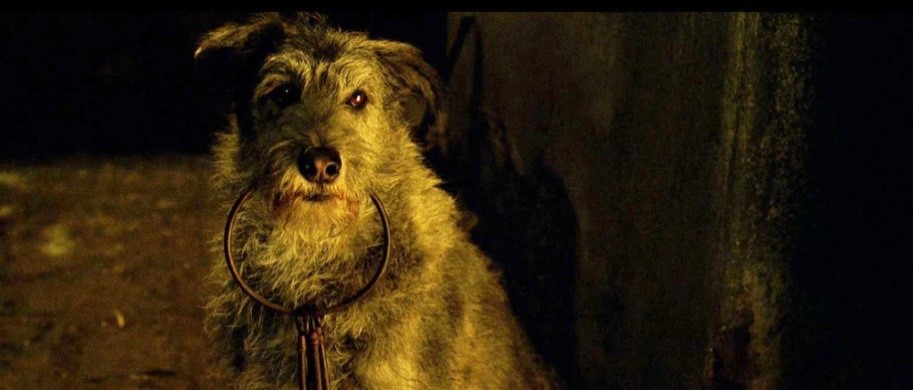
Cute factor: the prison dog will not relinquish the keys to freedom.
The inclusion of a dog in this scene, rather than another animal, plays on the trope of the ‘guard dog’, however unlike the conventional guard dog, this dog displays no aggression, being unable to bark of growl whilst holding the keys. Due to this, the dog is portrayed as a positive character, loyally refusing to move forward. Here, the dog is in a position of authority, acting as a jail-keeper and the difference between life and death for prisoners. This creates a moment of humour in an otherwise bleak environment, the dog almost taunting the pirates with the keys.
One way the pirates try to beckon the dog forward is with a bone, playing on stereotypes of dogs liking bones. However the inclusion of a bone takes on a more sinister meaning in an environment where prisoners would await execution.
Jack sees the futility in his fellow prisoners’ actions, stating ‘You can keep doing that forever. The dog is never going to move’, demonstrating a greater understanding of the dog’s behaviour, suggesting his familiarity with dogs and prison environments, reinforcing his status as a criminal.[1] This is one way the film adapts the Disney park ride, in which the dog remains stationary amongst moving pirate automatons. In this way, Jack’s dialogue acts as an inside joke for those familiar with the ride, in which the non-automated dog will literally never move. This scene additionally adds a sense of nostalgia to the film, as although Pirates of the Caribbean: The Curse of the Black Pearl has an adult target audience, a number of viewers are likely to recognise the scene from their childhood experiences of the Disney park ride. The use of a real dog in the film, as opposed to a prop, adds to the concept of bringing the ride to life through the medium of film, creating a convincing story rather than just an attraction. This also allows the dog to become a characterised individual, as it has the ability to display more realistic body language and facial expression than a prop animal.
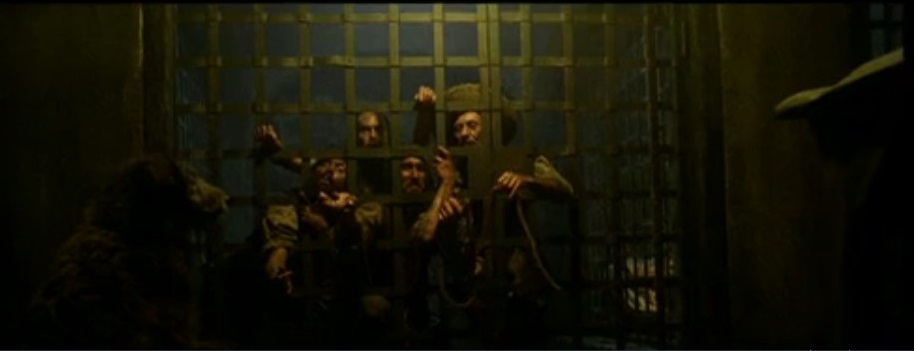
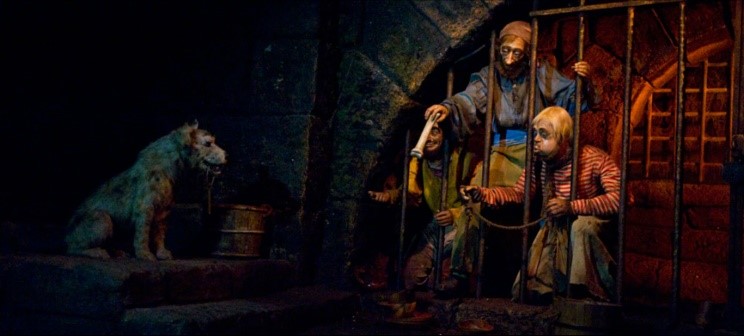
A faithful adaptation: The pirates attempt to entice the motionless dog forward in the film (left) vs the automaton from the Disney theme park attraction (right).
While Jack initially dismisses the efforts of the other pirates, he tries to coax the dog himself once they escape when their cell wall is destroyed by cannon fire. Here, Jack contradicts his earlier statement; his initial coolness and authoritative voice in front of the other pirates is proved to be an act, as he becomes equally desperate for the keys once alone with the dog. In his attempt to get the keys, Jack feigns friendliness towards the dog, crouching down to the dog’s level to gain eye contact, attempting to create an understanding between the pair. Although the dog appears encouraged by Jack’s efforts, Jack then insultingly calls him ‘filthy, slimy, mangy’ assuming a lack of understanding on the dog’s part, which causes him to depart, depicting the animal as intelligent.[2] The contract between Jack’s friendly tone of voice and his insulting language further presents him as a dishonest character, faking his sentiments towards the animal, despite his dislike for it, for his own personal gain, his selfish motives being reinforced throughout the film. Jack’s language additionally shows his resentment towards the dog’s authority, as well as prejudices of dogs being unclean, which may be accurate in the prison environment, which is depicted as equally filthy.
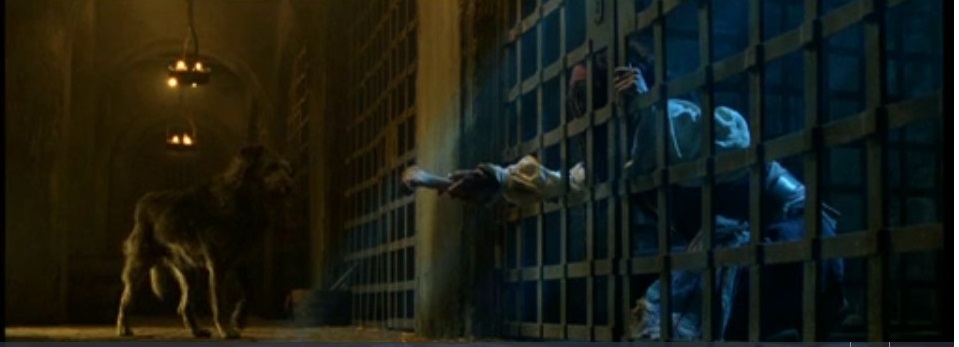
Jack’s inability to escape at this point in the film allows him to be aided in escape later by the film’s protagonist, Will Turner. In the escape scene, the dog is absent and no longer guarding the cells, something which allows Will and Jack to escape unseen, without much obstacle. In this way, the dog’s presence or un-presence in the prison becomes vital to allowing the plot to move forward, ensuring Jack escapes at the right point in the film, thus forming a relationship between himself and Will.
The dog remains a significant figure throughout the film franchise. In Pirates of the Caribbean: Dead Man’s Chest (2006) two escaped pirates have managed to gain possession of the keys by gaining possession of the dog, who remains holding them in his mouth. As the pirates approach Pelegosto Island in a small rowing boat, searching for the coveted ship the Black Pearl, the dog abandons the boat and swims ashore, still holding the keys in his mouth, while the pirates are washed ashore when the boat is wrecked. In this way, the dog shows his intelligence above the pirates, seeming to know that the boat will be wrecked; the pirates becoming comic figures, both through the physical comedy of the boat wrecking, and through the implication that they are less intelligent than the dog. Furthermore, the fact that the dog is still holding the keys, even though the pirates have already escaped and are miles away from the prison, reinforces the dog’s loyalty, keeping hold of the keys no matter what the circumstances. This additionally helps audiences remember the role of the dog in the first film.
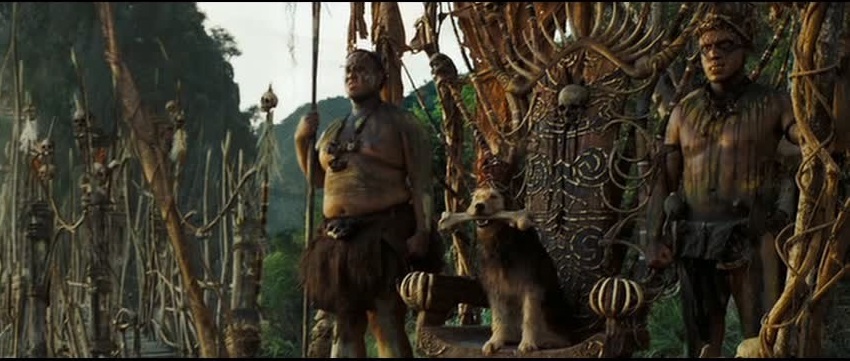
Swapping keys for bones: the prison dog as proud chief of Pelegosto Island.
Once on the island, is it revealed that Jack has become chief of a native tribe, who believe him to be a ‘god in human’ form, intending to ‘release him from his fleshy prison’ by killing and eating him.[3] While Jack escapes this fate, the dog is left behind on the island, causing the tribe to turn on the dog. Although initially running away, the dog is later shown in a cutaway scene as chief of the island, sitting on the tribal throne. As an animal, the dog is blissfully unaware of the tribe’s tradition of eating their chief. He appears content in his new position, exchanging his role as a service animal to an object of worship, something represented by the replacement of the keys he held for a large bone, an object of luxury for a dog. The worshiping of animals, along with the notion of animal sacrifice, are often viewed as archaic religious practices, reinforcing the ancient and cult-like nature of the tribe. This is additionally one way the film creates dramatic irony, as despite the dog’s satisfaction, the audience is aware that it will be killed. Thankfully, the dog evades being eaten, appearing again in the film’s third instalment, apparently escaping the island with the help of sea turtles, again adding humour to the film. The fact that the dog is not killed off in the second film suggests its role as a beloved, though minor, character, that audiences want to see again. In this way, the dog becomes an audience favourite, creating moments of humour and irony in otherwise dark films.
[1] Pirates of the Caribbean: The Curse of the Black Pearl. Dir. Gore Verbinski. Walt Disney Studios Motion Pictures, 2003.
[2] Pirates of the Caribbean: The Curse of the Black Pearl.
[3] Pirates of the Caribbean: Dead Man’s Chest. Dir. Gore Verbinski. Walt Disney Studios Motion Pictures, 2006